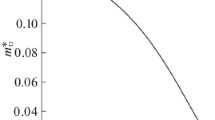Abstract
The concept of an ideal quantum wire as a one-dimensional heterostructure whose spectrum contains exactly one bound level of the transverse dimension-quantized motion is introduced. The admissible range of the radii of such a wire is calculated. It is shown that only the quantization of longitudinal levels of motion makes it possible to calculate the energy released (absorbed) upon the fusion of two wires of the same material. In the traditional approach of a continuous longitudinal spectrum, this effect cannot be determined in principle. The influence of a longitudinal magnetic field on the spectrum of ideal wires is considered. It is established that a quantizing magnetic field destroys the unique level with negative energy (relative to the bottom of the continuous spectrum of the environment) but creates a family of positive bound Landau levels. In this case, the density of states in the wire is completely determined by the magnetic field, which makes it possible to control its spectrum and conductivity.
Similar content being viewed by others
References
V. M. Ledentsov, V. M. Ustinov, V. A. Shchukin, et al., Fiz. Tekh. Poluprovodn. (St. Petersburg) 32, 385 (1998).
A. Ya. Shik, L. G. Bakueva, S. F. Musikhin, and S. A. Rykov, Physics of Low-Dimensional Systems (Nauka, St. Petersburg, 2001) [in Russian].
A. A. Barybin, V. I. Tomilin, and V. I. Shapovalov, Physicotechnological Grounds of Macro-, Micro-, and Nanoelectronics (Fizmatlit, Moscow, 2011) [in Russian].
M. Peshkin and A. Tonomura, The Aharonov–Bohm Effect (Springer-Verlag, Berlin, 1989).
G. N. Afanas’ev, “Old and new problems in the theory of the Aharonov–Bohm Effect,” Fiz. Elem. Chastits At. Yadra 21, 172 (1990).
L. Hackermüller, K. Hornberger, and B. Brezger, et al., Lett. Nature 427, 711 (2004).
D. Bowmeester, A. Ekert, and A. Zeilinger, The Physics of Quantum Information (Springer-Verlag, Berlin, 2000).
Y. Kondo and K. Takayanagy, Phys. Rev. Lett. 79, 3455 (1997).
J. Burki, C. A. Stafford, and D. L. Stein, Phys. Rev. Lett. 95, 090601 (2005).
V. Schmidt, J. V. Wittemann, S. Senz, and U. Gosele, Adv. Mater. 21, 2681 (2009).
M. M. Rojo, O. C. Calero, and A. F. Lopeandia, et al., Nanoscale, No. 5, 11526 (2013).
V. L. Popov, Mechanics of Contact Interaction and Physics of Friction (Fizmatlit, Moscow, 2013) [in Russian].
A. M. Mandel’, V. B. Oshurko, G. I. Solomakho, et al., Usp. Sovr. Radioelektron., No. 8, 18 (2015).
V. P. Kurbatsky, A. V. Korotun, A. V. Babich, and V. V. Pogosov, Phys. Solid State 51, 2520 (2009).
V. A. Harutyunyan, Phys. Solid State 52, 1744 (2010).
S. N. Grigor’ev, A. M. Mandel’, V. B. Oshurko, and G. I. Solomakho, Opt. Zh. 82, (5), 3 (2015).
S. N. Grigor’ev, A. M. Mandel’, V. B. Oshurko, and G. I. Solomakho, Opt. Zh. 82, (5), 11 (2015).
A. I. Baz’, Ya. B. Zel’dovich, and A. M. Perelomov, Dispersion, Reactions, and Disintegrations in the Nonrelativistic Quantum Mechanics (Nauka, Moscow, 1966) [in Russian].
A. M. Mandel’, V. B. Oshurko, and G. I. Solomakho, Elektromagn. Volny Elektron. Sist., No. 6, 67 (2014).
A. M. Mandel’, V. B. Oshurko, G. I. Solomakho, and A. A. Sharts, J. Commun. Techn. Electron. 60, 1117 (2015).
S. N. Grigor’ev, A. M. Mandel’, V. B. Oshurko, and G. I. Solomakho, Tech. Phys. Lett. 24, 1176 (2011).
C. Pryor, M. Flatte, J. Pingenot, and D. Amrit, g-Factor in Quantum Dots (2007). http://online.kitp.ucsb.edu/ online/spintr06/pryor/pdf/Pryor_KITP.pdf.
V. N. Rodionov, G. A. Kravtsova, and A. M. Mandel’, Teor. Mat. Fiz. 164, 157 (2010).
A. I. Ansel’m, Introduction to the Theory of Semiconductors (Nauka, Moscow, 1978) [in Russian].
Author information
Authors and Affiliations
Corresponding author
Additional information
Original Russian Text © A.M. Mandel’, V.B. Oshurko, G.I. Solomakho, K.G. Solomakho, 2018, published in Radiotekhnika i Elektronika, 2018, Vol. 63, No. 3, pp. 268–276.
Rights and permissions
About this article
Cite this article
Mandel’, A.M., Oshurko, V.B., Solomakho, G.I. et al. Ideal Quantum Wires in a Magnetic Field: Self-Organization Energy, Critical Sizes, and Controllable Conductivity. J. Commun. Technol. Electron. 63, 245–253 (2018). https://doi.org/10.1134/S1064226918030129
Received:
Published:
Issue Date:
DOI: https://doi.org/10.1134/S1064226918030129




